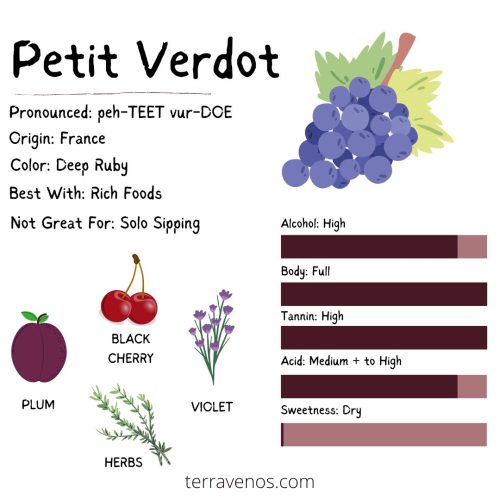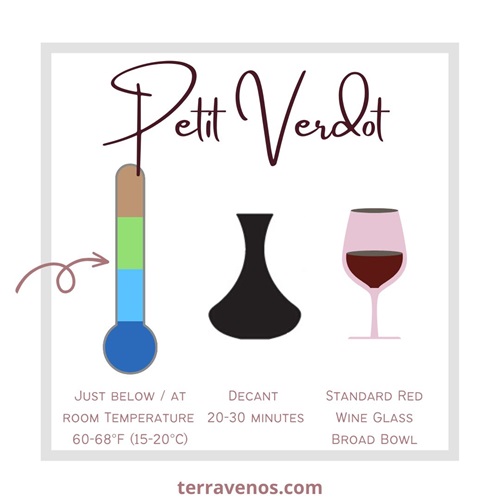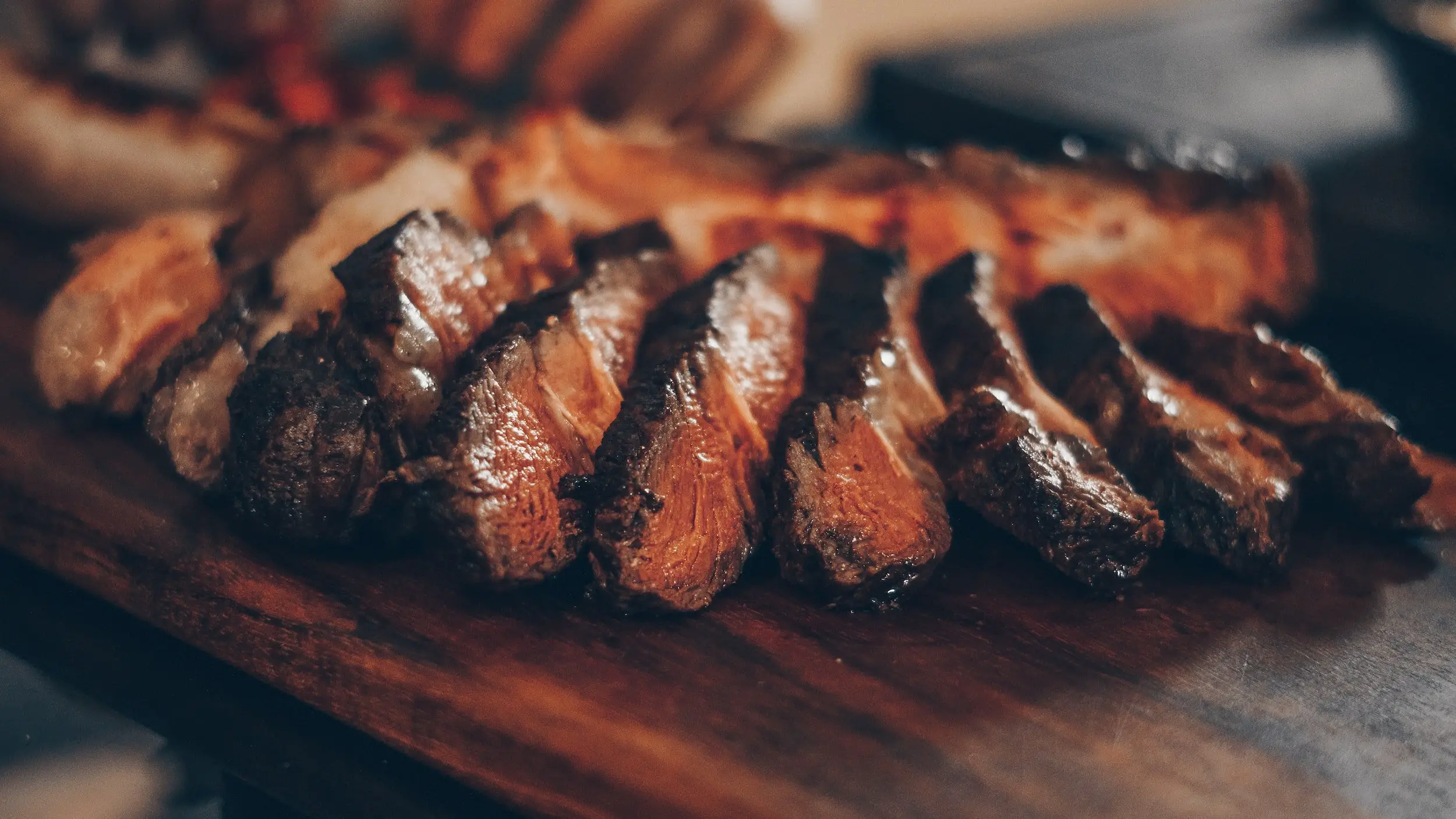
Pronunciation: peh-TEE ver-DOH
Petit Verdot is a red wine grape from France. Petit Verdot makes full-bodied, tannic, dry red wines with notes of plum, purple flower, and herbs. It’s most often used as a Bordeaux blending grape.
Here’s what you need to know about Petit Verdot wine.
- What Kind of Wine is Petit Verdot?
- Where Does Petit Verdot Wine Come From?
- What Does Petit Verdot Smell Like?
- What Does Petit Verdot Taste Like?
- How to Serve Petit Verdot Wine
- How Much Is Petit Verdot Wine?
- Petit Verdot Synonyms
- Petit Verdot Food Pairing Suggestions
- Petit Verdot vs. Other Varietals
- Notable Petit Verdot Producers and Bottles to Try
- Emerging Trends with Petit Verdot
- Thirsty for More?
What Kind of Wine is Petit Verdot?
Petit Verdot is a full-bodied red wine with medium-plus to high acidity, pronounced tannins, and elevated alcohol content. It stands on the bolder end of the spectrum, bigger than Cabernet Sauvignon and closer to Petit Sirah in style.
Fun Wine Fact: Petit Verdot, means “small green” in French, paying tribute to the late-ripening nature of this little French grape. It often ripens 2-3 weeks after Cabernet Sauvignon. It’s just hanging out in the vineyard doing it’s thing.
Where Does Petit Verdot Wine Come From?
Originating from Bordeaux, France, Petit Verdot has traditionally played a supporting role in blends, especially on the Left Bank. Scroll out on the map above to get a sense of where Petit Verdot is from.
While it is not as prevalent as Cabernet Sauvignon or Merlot, its contribution adds structure and complexity. Outside of Bordeaux, regions like Australia, California, and Argentina have embraced Petit Verdot, allowing it to shine both in blends and as a standalone varietal.
Fun Wine Fact: Because Petit Verdot is such a big, tannic wine, it’s usually added in small quantities to blends and not often made into a single varietal wine.
Petit Verdot in Bordeaux
In Bordeaux, Petit Verdot is one of the five major grape varieties, along with Cabernet Sauvignon, Merlot, Malbec, and Cabernet Franc. It is commonly used to enhance the tannic structure and add a layer of dark fruit and purple floral notes to the wine.
Petit Verdot Around the World
Beyond France, Petit Verdot has gained popularity in various wine regions. In regions like Napa Valley, it contributes to the complexity of Cabernet Sauvignon blends. Winemakers in Spain, South Africa, and Chile have also embraced Petit Verdot, showcasing its ability to thrive in diverse terroirs.
What Does Petit Verdot Smell Like?
Petit Verdot exudes a powerful and aromatic profile. Its nose often reveals intense dark fruit aromas, such as blackberry and black cherry, accompanied by delicate purple floral notes, and in some cases an herbal sage nuance.
What Does Petit Verdot Taste Like?
Petit Verdot’s flavor profile is characterized by boldness and depth. In cooler climates, it presents itself with a vibrant mix of dark berry and herbal notes, while warmer regions yield wines with a fuller body and rich, ripe fruit characteristics.
On the palate, Petit Verdot offers a combination of lively acidity and pronounced tannins, creating a wine that is both robust and structured.
Is Petit Verdot a Heavy Wine?
Petit Verdot can vary in weight, but most Petit Verdot wines are heavy.
Fun Wine Fact: Wines with higher alcohol content, typically above 14% ABV, will showcase a heavier and more full-bodied profile.
How to Serve Petit Verdot Wine

Temperature
Serve Petit Verdot slightly below room temperature, around 60-68°F (15-20°C), allowing its complex aromas to unfold while maintaining a refreshing coolness.
Glassware
Opt for a standard red wine glass with a broad bowl and a slightly curved rim. This design enhances aeration, directing the wine’s aromas toward your nose for an optimal tasting experience.
Should I Decant Petit Verdot?
Decanting may be necessary for fuller-bodied Petit Verdot wines, allowing them to open up and express their full range of flavors. Decant for 20-30 minutes or longer if needed, and if the wine seems closed, let it breathe for an additional 10 minutes.
Personal Note: I always need to let my Petit Verdot wines sit for 20+ minutes before enjoying to fully open up.
Petit Verdot Aging Potential
Petit Verdot, especially fuller-bodied and tannic expressions, can benefit from aging. Lighter styles may last between 2-5 years, while more robust wines can age for 5-10 years or longer.
Helpful Wine Fact: Acid, tannin, and alcohol act as wine preservatives. Petit Verdot has all three of these qualities, making it a good wine for potential aging.
How Much Is Petit Verdot Wine?
Petit Verdot Wine Price Points
| Price Point | Price Range |
|---|---|
| Entry-level | $12 – $20 |
| Premium | $25 – $40 |
| Super Premium | $40 and above |
Petit Verdot Synonyms
Petit Verdot is known by various names across different regions: Bouton, Carmelin, Heran, Lambrusquet Noir, Petit Verdau, Petit Verdot Noir, Verdot, and Verdot Rouge.
Petit Verdot Food Pairing Suggestions

Petit Verdot’s bold and robust nature makes it a versatile companion for a range of dishes. Embrace its dark fruit intensity by pairing it with grilled meats and rich, flavorful dishes.
Quick Tips: Petit Verdot Food Pairing
- Grilled ribeye steak with a blackberry reduction
- Lentil stew with frenchbread
- Grilled portabello mushrooms with asiago cheese
Discover More:
Red Wine and Cheese Pairing: What You Need to Know
Petit Verdot vs. Other Varietals
While Petit Verdot shares some characteristics with Cabernet Sauvignon, it boasts a distinct personality marked by its boldness and depth. Its intense dark fruit flavors and pronounced tannins set it apart from other red varietals.
Notable Petit Verdot Producers and Bottles to Try
When exploring Petit Verdot, seek out wineries that specialize in this varietal. Notable producers include:
- Château Margaux (Bordeaux, France)
- Mollydooker Wines (McLaren Vale, Australia)
- Achaval-Ferrer (Mendoza, Argentina)
These wineries showcase the diverse expressions of Petit Verdot, each with its unique style and character.
Emerging Trends with Petit Verdot
Yes, Petit Verdot is traditionally a blending grape, but more and more producers are making single-varietal bottles of Petit Verdot. These wines showcase Petit Verdot’s unique character. If you can find a wine that’s just Petit Verdot, it’s a fantastic experience to taste it to truly understand what this grape adds to other wines, like Bordeaux blends.
Final Thoughts – Petit Verdot as Must-Try Red Wine Varietal
With its bold and intense flavor profile, Petit Verdot stands out as a red wine varietal worth exploring. Here are three key takeaways:
- Distinctive Flavor Profile: Petit Verdot offers intense dark fruit flavors, delicate floral and sage notes, and pronounced tannins, creating a wine with depth and complexity.
- Food Versatility: Pair Petit Verdot with hearty and flavorful dishes, allowing its boldness to complement and enhance the dining experience.
- Global Appeal: From Bordeaux to Australia and Argentina, Petit Verdot has found a home in diverse wine regions, showcasing its adaptability and global appeal.
Thirsty for More?
I’m a big believer in doing side-by-side tastings to boost your wine knowledge. Here’s how to host your own wine tasting for beginners.
Check out this post on Cabernet Sauvignon vs Merlot, another popular red wine, along with Cabernet Sauvignon vs Malbec, and Shiraz vs Merlot.



